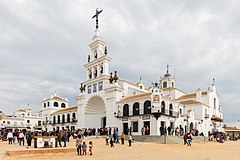El Rocío
| Hermitage of El Rocío | |
|---|---|
| Ermita de El Rocío | |
 |
|
| Alternative names | Ermita de la Virgen del Rocío Hermitage of the Virgin of El Rocío |
| General information | |
| Type | Hermitage |
| Town or city | Almonte (Province of Huelva) |
| Country | Spain |
| Construction started | 1964 |
| Completed | 1980 |
| Inaugurated | 1969 |
| Design and construction | |
| Architect | Antonio Delgado y Roig and Alberto Balbontín de Orta |
| References | |
| El Nuevo Santuario del Virgen del Rocío, hermandadrociosevilla.com, retrieved 2010-04-14, for the dates of construction. | |
The Hermitage of El Rocío (Spanish: Ermita del Rocío or Ermita de El Rocío) is a hermitage at El Rocío in the countryside of Almonte, Province of Huelva, Andalusia, Spain. The hermitage is home to the Virgin of El Rocío (Spanish: Virgen del Rocío), a small, much-venerated carved wood statue, and is the destination of an annual procession/pilgrimage on the second day of the Pentecost, known as the Romería de El Rocío, connected to the veneration of the Virgin of El Rocío; in recent years the Romería has brought together roughly a million pilgrims each year.
Although there has been a hermitage on this site for centuries, the present hermitage building was designed by architects Antonio Delgado y Roig and Alberto Balbontín de Orta, designed in 1961 and built in stages over the next two decades.
The historical chronicles say that King Alfonso X of Castile (Alfonso the Wise), present on the site in 1270, ordered the construction of a hermitage dedicated to the Virgin Mary in the place then known as Las Rocinas, which had recently been reconquered from the Muslims who at that time still ruled much of southern Spain. The same chronicles say that attracted by the beauty of the area and its abundant deer, Alfonso established himself a hunting preserve there in 1269, first known as the Coto Real del Lomo del Grullo y Las Rocinas, which largely coincides with today's Doñana National Park or Coto de Doñana.
The first Hermitage of El Rocío was a simple Mudéjar building constructed some time after Alfonso's 1270 command, and built no later than 1300 (Juan Infante-Galán Zambrano says 1270–1284, but also says that the first firm documentary evidence of the hermitage dates from 1337). The statue of Our Lady of El Rocío certainly dates back to this building, though its precise date and origin are a matter of some controversy.
...
Wikipedia
